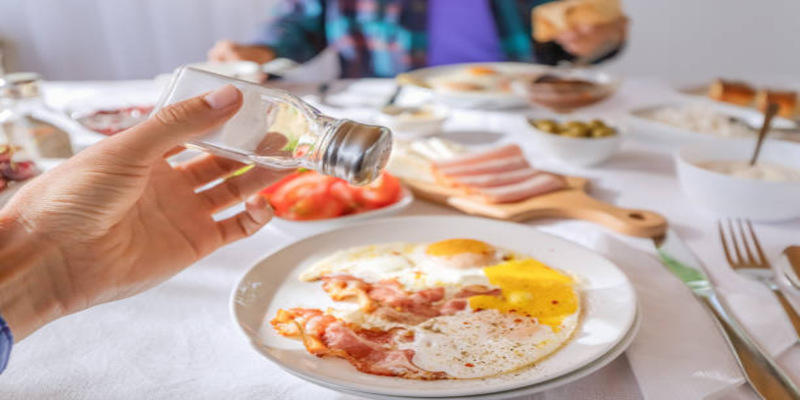An essential mineral that we need in our daily lives is sodium. Sodium keeps the fluids balanced in our body and helps muscles and nerves work smoothly. But our body retains excess water when we eat more sodium than we need. That’s why the organs of our body work harder, especially the heart. That can cause heart stroke, high blood pressure, and cardiovascular diseases.
Salt is made with sodium and chloride. So, sodium is mainly referred to as salt. It is used as seasoning in our daily foods and adds flavors. But most Americans consume five times more salt than they need.
Let’s find out the foods high in sodium Americans consume too much.
Foods That Are High in Sodium Americans Consume

Salt is the main ingredient in our daily foods. So, it is natural that the average sodium intake can be increased with the intake of salty foods. The foods naturally high in sodium are spinach, tomatoes, swiss chard, etc. Some of the foods that are high in Sodium Americans consume are:
Soup
All types of soup canned, packaged, and restaurant-prepared are a bomb of high sodium. The average amount of sodium in soups is 1400-1800 milligrams; some may exceed this amount. So, if you only eat ½ cup of soup, you consume approximately 900mg of sodium, which can harm your health.
Cottage Cheese
Cheese is a good protein and calcium source but is also high in sodium. There is also low-sodium cheese available. The high-sodium cottage cheese ½ cup contains 18% sodium and other nutrients.
The salt is used in cottage cheese as a flavor enhancer and preservative. So, mostly cottage cheese is salty. However, you can decrease sodium by draining it under running water for a while.
Frozen Fish and Meals
Like ham and fish, most frozen foods are added with extra salt to enhance flavor and perseverance. One cup of ham includes 1684mg of sodium, a significant amount. You can’t find ham low in sodium. So, try to avoid ham as a complete meal or per serving. Use it occasionally in small amounts.
Frozen meals are also rich in sodium. So try to avoid buying frozen meals and prepare your meals at home that are fresh, healthy, and low in sodium.
Vegetable Juice
A healthy vegetable juice can be high in salt if it is canned or packaged. You must pay close attention to the labels and see the amount of salt in the juice. For instance, a can of tomato juice can be high in sodium. It’s better to make fresh vegetable juices at home that are fresh and low in sodium, with no extra sodium to preserve.
Sauces
Sauces, condiments, and salad dressings add flavor to our food, but whoever thinks a small amount of sauces is a blast of sodium in your food. One tablespoon of soy sauce contains 1000mg of sodium, and one cup of spaghetti contains 1000mg of sodium. Lower sodium content sauces can also be added to meals but are not available everywhere.
Savory Snacks
Savory snacks like chips, fries, and crackers are high in sodium, fat, and calories, which are unhealthy for our health. A medium serving of 117 grams of french fries contains 246 grams of sodium. So, try to avoid most of the savory snacks. You can also use baked potatoes if you are a lover of potatoes. This will reduce your craving for snacks and intake of salt.
Fast Food
If you are following a low-sodium diet, you should avoid fast food containing pizza, burgers, fries, chicken fingers, and fried chicken. Fast food is a rich source of sodium, which may cause heart disease and also cause bloating. A regular pizza slice contains 640mg of sodium, and whoever stops on one slice. Avoid all these fast foods or use them occasionally as there is no option for low-sodium fast food.
Burritos and Tacos
Burritos and tacos also have a high sodium content. 2 pieces contain 980 gm of sodium, and each taco has 274 gm of sodium. So, take a small portion of this salty meal.
More Foods That Are High in Sodium

Along with the above, more foods high in sodium Americans consume are salted fried nuts, breakfast cereals, breads, shrimp, instant pudding, sandwiches, tortillas, pickles, hot dogs, sausages, and bacon.
What is the Recommended Sodium Intake By Age?
The recommended sodium intake by age by the Institute of Medicine(IOM) is as follows:
Age | Sodium intake |
1 to 3years | 1000mg(milligrams)=less then half teaspoon |
4 to 8years | 1200mg=half teaspoon |
9 to 50years | 1500mg=less then ¾ teaspoon |
51 to 70years | 1300mg=more than a half teaspoon |
70 years onwards | 1200mg=half teaspoon |
Too Much Sodium Symptoms
When you overeat sodium, your body gives you alarming signs. Understanding these signs, you should reduce sodium or salty foods to remain healthy. Some of the common symptoms of too much sodium consuming symptoms are as follows:
- You will feel bloated after every meal.
- Your blood pressure remains high most of the time.
- Swelling on hands, feet, and face.
- You often feel thirsty because the excess sodium pulls out water from your body cells.
- You are gaining weight gradually.
- Sleep is disturbed; you wake up frequently at night and feel unwell in the morning.
- Feels weak and suffering most of the time.
How Much Sodium Per Day With High Blood Pressure?
American Heart Association recommends that a healthy person take no more than 2300mg of sodium. A person with high blood pressure should take no more than 1500 mg daily. Even if you cut back to 1000mg daily, it can help maintain blood pressure and heart health.
Final Words
About 70% of Americans face high blood pressure and 48.1% hypertension, which is caused by excessive use of sodium-rich foods in their life. Most canned, processed, restaurant, bakery, and frozen foods have high sodium content. So, to enjoy a healthy life, avoid unnatural and processed food. Prepare and eat homemade, fresh, and nutritious meals.







